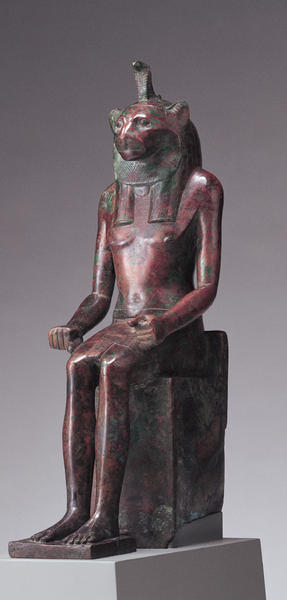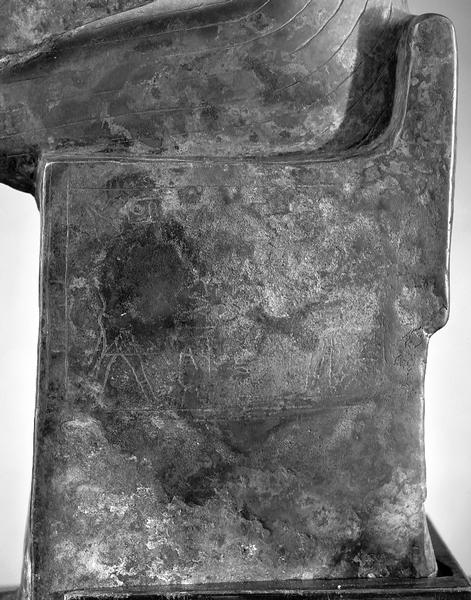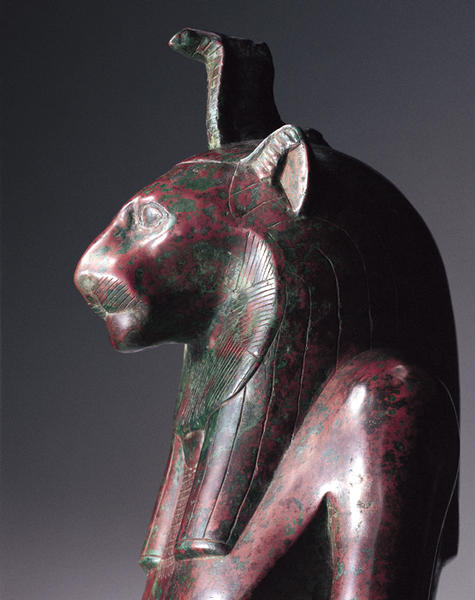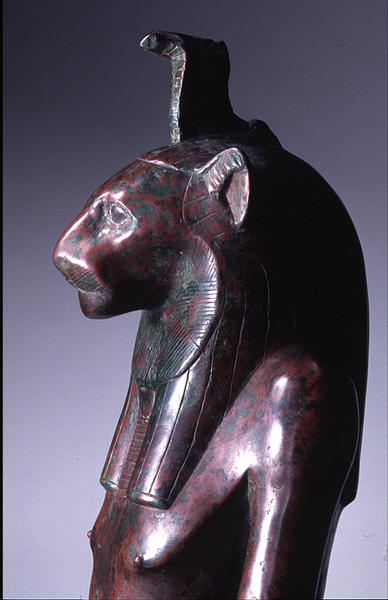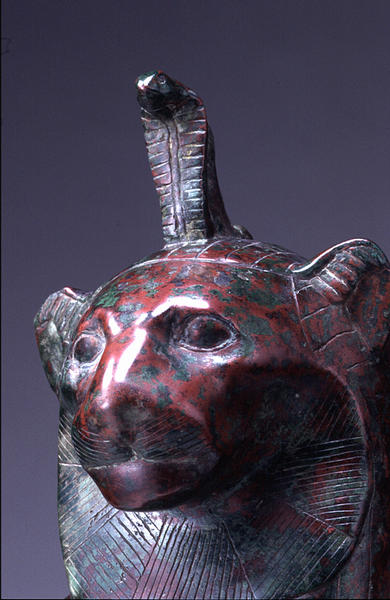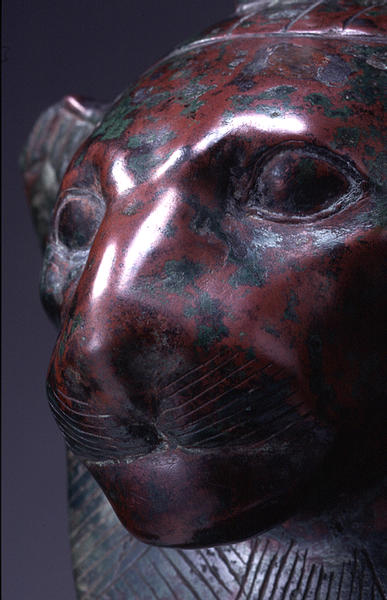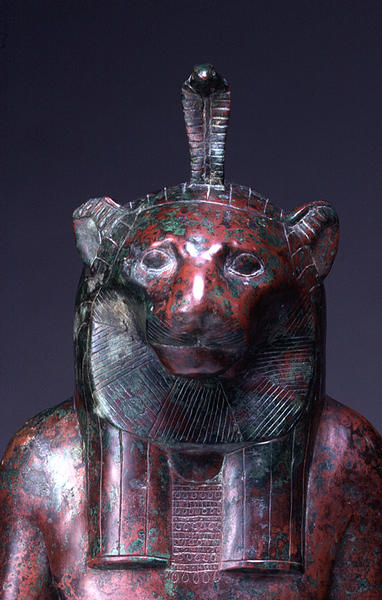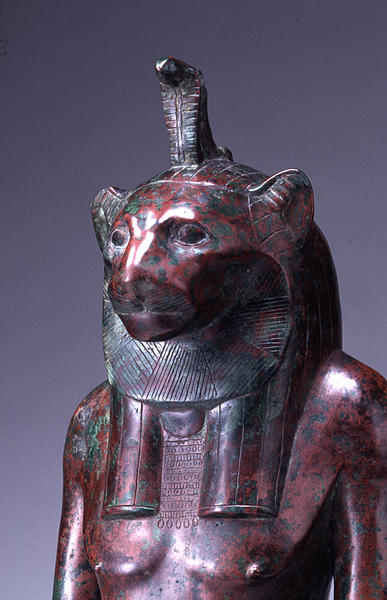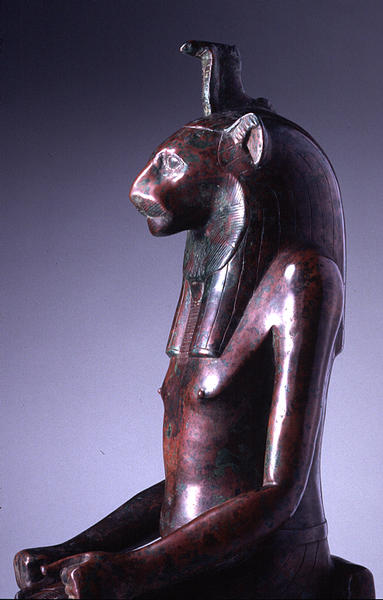獅子頭神像
- エジプト
- エジプト第25王朝後期-第26王朝時代
- 前690-前525年頃
- 青銅
- H-61.5 D-33 W-17.5
下エジプト・デルタ地帯のブトの町では太陽神ラアの娘または妻と言われる雌ライオンの神バストが信仰されたが、その息子といわれるミホスはライオン頭のホルスとされた。その玉座に一部残された王名から、このホルス像はヌビア王ピアンキまたはペルシャ王ダレイオスの時代に王によって神殿に奉納された可能性が考えられている。
神殿の奉納像について
神殿の奉献の部屋は最奥部の至聖所より1以上室程隔たった前室にあたり、大小の青銅の奉納像に加え、小さな陶製やフェイアンス製の小像の類もつめこまれ、それが限度を越えるとそれらは神殿内から取り出され、境内の大きな穴に埋蔵されました。
多くのそのような場所が見つかっていますが、1903年にカルナック神殿の境内で17000ものブロンズ小像と751の大きな像といった大量の奉納像が発掘されています。
隼頭神像
なぜ奉納されたのか
永遠の至福を求めるエジプト人は、更に個人的に神像を造立し神殿に奉納しました。
これらの像の足元には奉納者の名前が刻まれていましたが、これは奉納者のkaがその名前とともにそこに生きていると考えられたのです。
これらは神殿内部に収められることによって、奉納者がその名前を不朽のものとし、死後も神に捧げられた供物と祭祀に与り、永遠の至福を享受する事を願ったものだったのです。
隼頭神像
獅子の頭部を持ったホルス
隼の頭部を持った神を代表とする太陽神信仰は、様々な神々を融合させて行きました。
下エジプト・デルタ地帯の一地域ブトの神で、ライオンの頭部に王権の象徴であるウラエウス(立ち上がるコブラ)と太陽円盤を頂いたバスト(Bast)はラァの娘または妻であると見做され、その息子ミホス(Mihosまたはマアヘス/Mahes)は、ホルスの一形態である、「賞賛のホルス」と見做されました。
この像高60cm、ライオンの頭部を持った神像は、冠ではなくウラエウスを頂いていますが、ラァの息子ミホスすなわちライオン頭のホルスをあらわしたものであると思われます。
玉座の類例について
大英博物館のライオンの頭部を持った神像(BM11482)は木彫で、玉座の左側には青冠を右側にはネメス頭巾を被った王が神に奉納している場面が描かれています。
王の斜め上方と前方におかれたカルトゥーシュ内の名前からこれは第26王朝アマシスII世であることがわかります。
・T.G.H.James/ A Wooden Figure of Wadget with two Painted Represantations of Amasis/ Journal of Egyptian Archaeology Vol.68 1982
ボロニャ市博物館の像はブロンズで、玉座の左側には下エジプトの冠を、右側には上エジプトの冠を被った王が神に奉献している場面が描かれています。
この場合はカルトゥーシュの王名からこれは第26王朝のプサンメティクI世であることがわかります。
・Jacques Vandier/ Un Bronze de la desse Ouadget a Bologne/ Zeitschrift fuyr AEgyptische Sprache und Altertumskunde 97 1971
玉座について
この像の玉座には、腐食が激しいのですが、右側上部に下エジプトの冠を頂いた王が、左側上方には上エジプトの冠を頂き伝統的なキルトをつけた王が、玉座に座した神に供物を捧げている光景が描かれているのが見えます。
王の頭部の斜上方には、王名をあらわす聖刻文字がカルトゥーシュに囲まれて書かれています。
それは辛うじて二文字までは読み取ることができ、名前のイニシャルからある程度限定して、この王が誰であったか推測することができます。
これを仮に個人の奉納像が多く作られるようになったといわれる第二十二王朝以降のものとすれば、ヌビアの王ピアンキ(8-7世紀B.C.頃)又はペルシャの王ダリウスI世(第27王朝521-486 B.C.)に相当する可能性もあります。
ヌビアはエジプトの南の民族であり、ペルシャとはアケメネス朝ペルシャをさしています。どちらも異民族にエジプトが支配された時代であり、ヌビア王やペルシャ王の大望があるいは込められていたものかもしれません。
Catalogue Entry
Remarkable for its size, high level of technical execution, and excellent state of preservation, this Egyptian bronze depicts an enthroned male lion-headed deity. The god is seated on a low cuboidal throne, which is engraved with scenes on the sides and back, and once held an ankh (symbol of life) in its proper right hand and a long was- or wadj-scepter in the other, features shared by another large-scale Egyptian bronze in the Shumei collection (cat. no. 8). The deity is surmounted by a headdress with a single erect cobra, wears a wesekh collar composed of six rows of tubular and six rows of oval beads, and a shendyt, or wrapped kilt. In addition to indicating the necklace and garment, engraved lines articulate the long parallel locks of the tripartite wig and embellish the wide ruff encircling the lower portion of the lion's head. The arms, torso, and legs are well proportioned and naturalistic, providing clear evidence that a male deity is indicated, with flat, ridge-like pectorals.
Writing in 1967, the accomplished French Egyptologist Jacques Vandier compared forty-five enthroned lion-headed bronze figures, measuring from 20 to 58 cm in height.1 Based on iconography and inscriptions, he distinguished two deities--the goddess Wadjet, Mistress of Buto of the Delta, and her son Horus, whose cult was also established at Buto. The Shumei lion-headed deity was included as an addendum to this study, with the notation that it was accessible to him in a private collection at that time and should be considered as a depiction of the lion-headed Horus.2 Of the ten other lion-headed bronze images of Horus identified by Vandier,3 a large (58 cm) figure now in the Berlin Museum most closely compares with the Shumei example, and bears a significant text. A dedicatory inscription on the socle of the Berlin figure reads: "Horus, son of Wadjet, gives life to Horwadja...."4 Not only does this identify the deity as Horus, but it narrows the many personifications of Horus through affiliation with his mother Wadjet. By association, it is likely that the Shumei figure depicts the same deity, and was commissioned for use in the cult center of Buto, located in the sixth nome of the Delta.
The cuboidal thrones from this series of bronzes bear varied images--offering scenes, feather patterns, and empaneled designs of heraldic plants. The throne of the Shumei figure is particularly interesting, with two rare depictions of royal offering scenes. More clearly visible is the scene on the left side (fig. 1), a king wearing the crown of Upper Egypt and a triangular kilt standing before an offering table and a seated deity. The remains of an inscription enclosed within a cartouche provide further indication of the royal aspect of the scene, yet it is largely illegible.5
Lacking clear archaeological data, Vandier based his dating for the series of lion-headed figures on orthographic evidence from three examples6 and ascribed the series to the late Twenty-fifth or early Twenty-sixth Dynasty. The high level of technical expertise evidenced by other bronzes from this period further corroborates this attribution. The production of substantial images of the regional deity, Horus of Buto, who originated in Lower Egypt, is logical at this time when a local dynasty of Sais in the Delta was rising in influence and consolidating political power throughout the country.
NT
1. Vandier 1967, pp. 7-75.
2. Vandier 1967, pp. 73-75.
3. Vandier 1967, p. 49, nos. 1-10.
4. Roeder 1956, pp. 69-70, pl.12a,b,d,e, figs. 87-90; Vandier 1967, pp. 23-25, fig. 9.
5. Vandier (1967, p. 75) read the first sign as a solar disk (Re'), with a tentative identification of the second as a scarab (hpr), possibly providing the name Khepekare' (Nectanebo I, r. 380-362). The second sign also resembles an s (folded cloth?), and might indicate Darius I (r. 521-486 B.C.) or the weh (swab) of Wehibre' (Psamtik I, r. 664-610). Unfortunately, extensive technical analysis by the Conservation Center of the Los Angeles County Museum of Art has not revealed any additional information on this fragmentary inscription.
6. Vandier 1967, pp. 15-17, 21-22, 65.
